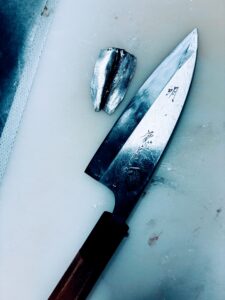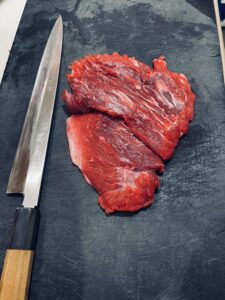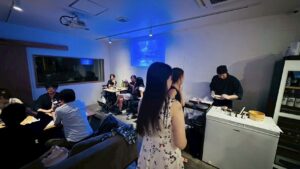A Delicate Duel with “Shinko” – What Baby Kohada Taught Me About Summer Work
Hello everyone, this is Sushi Batake. Today, I’d like to share a story about a true summer delicacy in the sushi world: shinko, or baby kohada (gizzard shad).
“Shinko” appears only briefly each year, usually from early summer to just before Obon. These fish are incredibly small—about 5 cm in length, and once you remove the head and tail, you're left with just 3 to 4 centimeters of edible flesh. It’s a short-lived, delicate ingredient that puts a sushi chef’s skill to the test.

Why It’s Called “A Single-Piece Work of Art”
The battle begins at the preparation stage. First, the tiny fish must be carefully scaled, gutted, salted, and then lightly pickled in vinegar. If you make a mistake at any stage, there’s no going back. That’s how fragile this fish is.
Because of their size, you can only rely on the tip of your knife. Like in the photo above, I use the very point of my deba knife to work with each fish—one by one, as if I’m speaking directly with them. That’s why this is often called “a single-piece work of art.”
A Completely Different Taste from Adult Kohada
Though it’s the same fish, mature kohada boasts strong umami, rich oils, and a pronounced flavor from the curing process. Shinko, on the other hand, is the opposite—light, ephemeral, yet with a distinct outline of fish flavor. It’s like tasting the summer air itself.
Whenever I serve it, I make sure to tell guests, “This sushi is only available now.” Because once this season passes, you won’t see shinko again for another year.
“Small Mistakes Lead to Complete Collapse”
When working with shinko, balance is everything. The rice size, the strength of the vinegar, how much salt is rinsed off—even the smallest misstep will ruin the entire piece.
When I prepare this neta, it feels almost like the meditative moment of serving tea in a traditional ceremony. I steady my breath, release all tension, and tune in to the voice of the fish. Without that mindfulness, this tiny life will never truly become “sushi.”
Feeling the Season Through Guests’ Reactions
As summer approaches, I start to hear familiar questions from regular customers: “Do you have shinko again this year?” It’s a joy as a chef to know that guests are experiencing the season through sushi.
Shinko is one of the more expensive neta for its size, but those who seek it come back for it year after year. There’s something irreplaceable about its presence—a luxury that can only be enjoyed for a fleeting moment.
Capturing the Memory of Summer in a Single Piece
I believe sushi is food that creates memories. And ingredients like shinko—those tied to a specific time of year—carry the memory of that summer itself.
I, Sushi Batake, currently work at Sushikawa in Sasazuka, and also offer private sushi catering and hands-on sushi experiences throughout Tokyo. Seasonal ingredients like shinko are prepared with care based on that day’s market availability and condition.
If you’d like to try something rare, or want sushi that reflects the season, feel free to reach out. I’d be honored to share “small luxuries” like shinko with you, wherever you are.
Looking to savor seasonal sushi in Tokyo? For expertly crafted sushi and rare seasonal neta, Sushi Batake is here for you!


